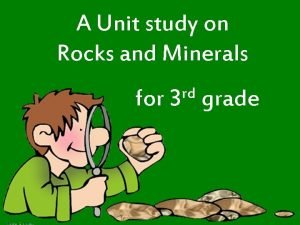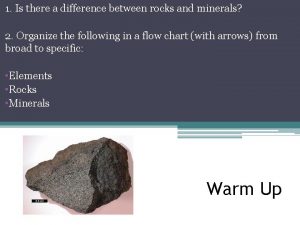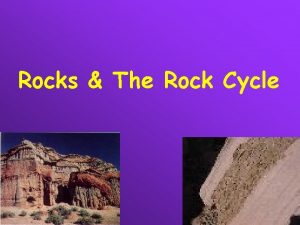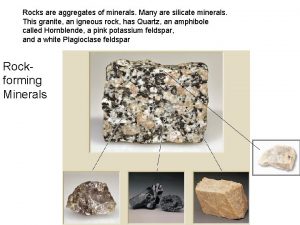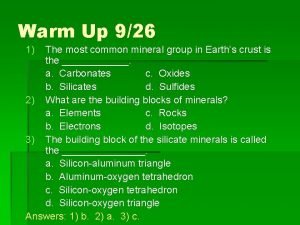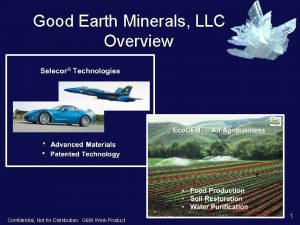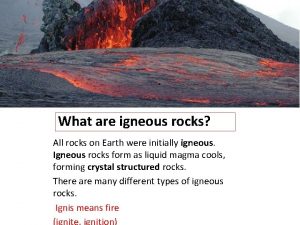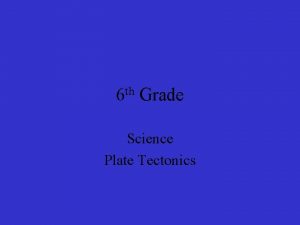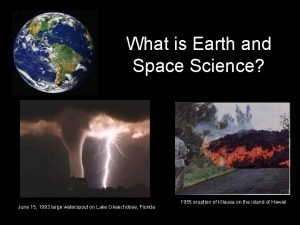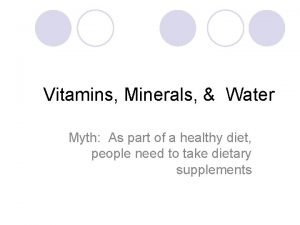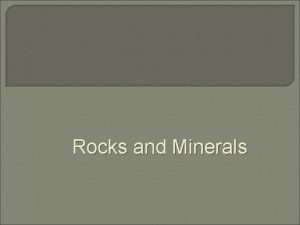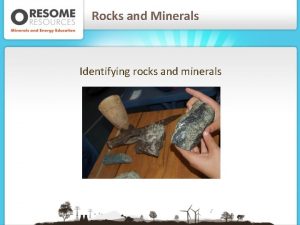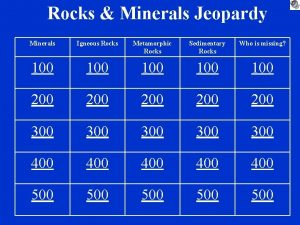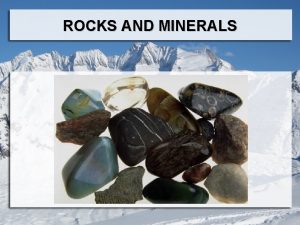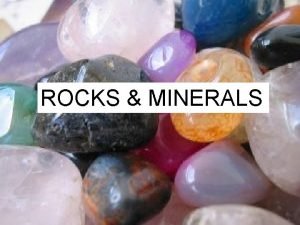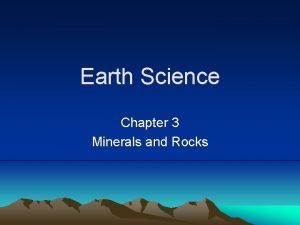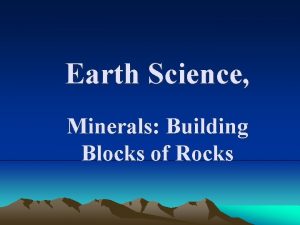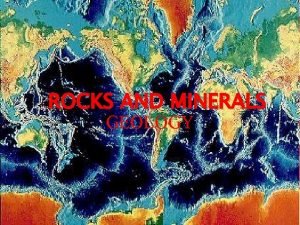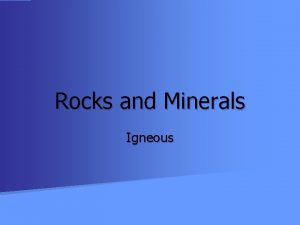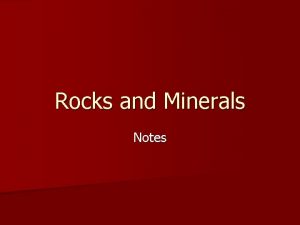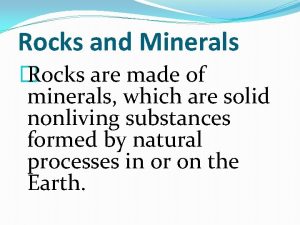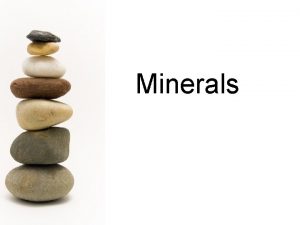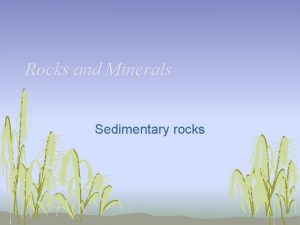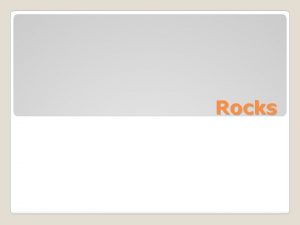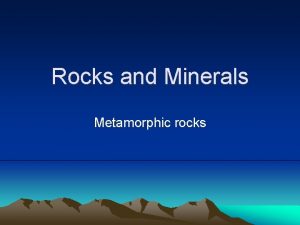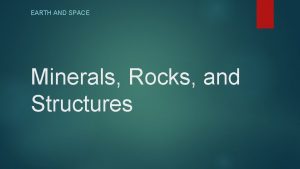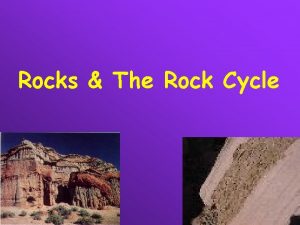Minerals Rocks Earth Science Rocks and Minerals 20





















- Slides: 21

Minerals & Rocks Earth Science: Rocks and Minerals (20: 00 min)

Minerals • Minerals are pure substances made up of only one type of matter through the process of crystallization. – Crystallization is the process by which atoms are arranged to form a material with a crystal structure. 1. melted materials (magma or lava) – Deep Magma = slow cooling & large crystals – Shallow Magma = faster cooling & small crystals – Lava = fastest cooling & no crystals 2. materials dissolved in water – Calcite – weathering from carbon dioxide.

Characteristics of Minerals • Characteristics: 1. Are naturally occurring • Cannot be man made 2. Inorganic • Cannot come from something once living 3. Definite chemical composition • Element = single atom. – • Gold (Au), Silver (Ag), Iron (Fe) Compound = two or more elements combined. – Calcite (Ca. CO 3), Talc (Mg 3 Si 4 O 10(OH)2)


Identifying Minerals • Each mineral has its own specific property used to identify it: 1. Hardness • The resistance of a mineral to being scratched. – Mohs Hardness Scale: » 1 = softest (Talc), 10 = hardest (Diamond)

selenite Fingernail (2 -3) Copper Strip (3) Glass Plate (5. 5 -6) microline Porcelain Streak Plate (6. 5 -7) 9

Identifying Minerals 2. Streak • The color of the powder left after being rubbed on a tile.

Identifying Minerals 3. Luster • The ability of a mineral to shine or reflect light. – Metallic – Dull – Pearly – Vitreous

Identifying Minerals 4. Cleavage • The tendency of a mineral to break along regular surfaces in one or more specific directions.

What is a Rock? • A mixture of minerals and other materials. – Granite = quartz, feldspar, mica and hornblende. • Geologists study and classify rocks based on: – Color – Texture – Mineral composition

Texture • Texture is look and feel of the rock’s surface. – Grains give a rock its texture. • Grain Size: coarse, fine or no visible grains • Grain Shape: Rounded, jagged • Grain Pattern: Banded or nonbanded.

Rock Types 3 Major groups of rocks: 1. Igneous Rock – Come from the cooling and crystallization of extremely hot liquid rock (lava or magma) • • • Slow cooling = large crystals Rapid cooling = small crystals Extra-fast cooling = no crystals – First rock type to have formed on Earth – “Igneous” = Greek for “fire”

Classifying Igneous Rocks • Origin Extrusive – lava cooling at Earth’s surface Intrusive – Magma cooling within Earth’s crust. – – • Texture Fine grained – rapid cooling coarse grained – slow cooling – – • Mineral Composition – • – • Mafic (Iron & Magnesium) dark colored Felsic (Aluminum) light colored


Rock Types 2. Sedimentary Rock – Particles of rocks or remains of plants and animals that are compacted and cemented together. • Deposited in layers by water, wind and ice. • Classified into 3 groups based on how they were made: – Organic – formed from remains of living things; plants and animals – Chemical – formed when elements dissolved in water came out of solution. – Clastic – formed when particles that were weathered from other rocks were cemented together.

Shell Limestone

Rock Types 3. Metamorphic Rocks – “Changed Rock” – When existing rock; sedimentary, igneous or metamorphic, has its texture, structure and composition changed by heat, pressure or chemical reactions. • Two texture groups: – Foliated – platy or leaf-like minerals (mica or chlorite) are nearly aligned parallel to one another. • Splits along well-oriented, parallel lines – Non-foliated – randomly oriented platy minerals, massive. • Break into angular pieces


The Rock Cycle • A series of processes on Earth’s surface and inside the planet that slowly change rocks from one kind to another = rock cycle. – Builds, destroys and changes the rocks in the crust. • What process drives the rock cycle? Plate Tectonics

The Rock Cycle

The Rock Cycle • Rock formed from the cooling of melted rock is called: Igneous Rock • Rock formed by weathering and erosion is called: Sedimentary Rock • Rock formed by heat and pressure is called: Metamorphic Rock
 Igneous vs sedimentary or metamorphic
Igneous vs sedimentary or metamorphic Compaction and cementation
Compaction and cementation Rock type
Rock type Why is bowen's reaction series important
Why is bowen's reaction series important Difference between rocks and minerals
Difference between rocks and minerals Concept map of rocks
Concept map of rocks Poem about minerals and rocks 3 stanza
Poem about minerals and rocks 3 stanza Whats the difference between rocks and minerals
Whats the difference between rocks and minerals Rocks and minerals
Rocks and minerals Rock vs mineral
Rock vs mineral Rocks are aggregates of minerals
Rocks are aggregates of minerals Most abundant minerals in earth's crust
Most abundant minerals in earth's crust Good earth minerals
Good earth minerals Extrusive rock
Extrusive rock Volcanic rocks and plutonic rocks
Volcanic rocks and plutonic rocks Math is my favorite subject
Math is my favorite subject Initially all rocks on earth were
Initially all rocks on earth were Breaks in earth's crust where rocks slipped past each other
Breaks in earth's crust where rocks slipped past each other Earth science part d
Earth science part d Space definition science
Space definition science What are vitamins functions
What are vitamins functions Which weather map symbol is used to represent violently
Which weather map symbol is used to represent violently




